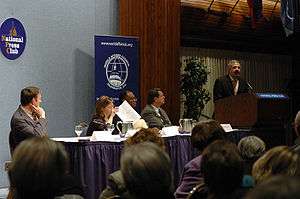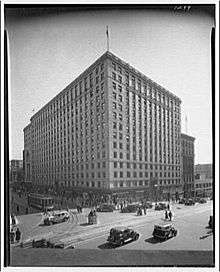National Press Club (United States)

The National Press Club is a professional organization and business center for journalists and communications professionals. It is located in Washington, D.C. Its membership consists of journalists, former journalists, government information officers, and those considered to be regular news sources. It has gatherings with invited speakers from public life as well as a venue open to the public to host business meetings, news conferences, industry gatherings and social events.
| Sample of Luncheon Speakers | |
|
| |
|
| |
|
|
Founded in 1908, every U.S. president since Theodore Roosevelt has visited the club, and all since Warren Harding have been members. Most have spoken from the club's podium. Others who have appeared at the club include monarchs, prime ministers and premiers, members of Congress, Cabinet officials, ambassadors, scholars, entertainers, business leaders, and athletes. The Club's emblem is the Owl, in deference to wisdom, awareness and nights spent working.
History
On March 12, 1908, 32 newspapermen met at the Washington Chamber of Commerce to discuss starting a club for journalists. At the meeting they agreed to meet again on March 29 in the F Street parlor of the Willard Hotel to frame a constitution for the National Press Club. The Club founders laid down a credo which promised "to promote social enjoyment among the members, to cultivate literary taste, to encourage friendly intercourse among newspapermen and those with whom they were thrown in contact in the pursuit of their vocation, to aid members in distress and to foster the ethical standards of the profession."
With $300, the founding members moved into its first club quarters on the second floor of 1205 F Street NW. By 1909, the club had outgrown its new quarters and moved above Rhodes Tavern at the corner of 15th and F Streets. Once again the club outgrew its residence and moved to the Albee Building (formerly Riggs) at 15th and G Streets.
National Press building

In 1925, National Press Club President Henry L. Sweinhart, appointed a special building committee to plan for a permanent club headquarters. The Ebbitt Hotel was demolished, and the Ebbitt Grill moved to the Albee building. The new National Press Building was completed in August 1927, and included retail space and office space intended for Washington news bureaus, with the club occupying the 13th and 14th floors. In order to increase their funding, the club made a deal with movie studio 20th Century Fox to build a theater as part of the building.
In 1932, Bascom N. Timmons, who established an independent news bureau in Washington, D.C., became president of the Press Club. He worked to save the press club building in New York City from foreclosure by persuading President Franklin Roosevelt to sign an amendment to the federal bankruptcy law that blocked pending foreclosure and kept the building open.[4]
The National Press Building was renovated from 1984 to 1985,[5] in conjunction with the development of the adjacent The Shops at National Place. Beginning in 2004, a 10-year, $15 million second renovation occurred.[6] In 2011, the building was sold to Quadrangle Development Corp. and AEW Core Property Trust (U.S.) for $167.5 million.[5][7] The owners placed the building, assessed at $237.5 million, up for sale in August 2014.[6]
Membership
During the Great Depression, the Club struggled financially as it was beginning to be recognized as an influential group. It managed to find additional funding from wealthy individuals.
Regular weekly luncheons for speakers began in 1932 with an appearance by president-elect Franklin D. Roosevelt. Since then the Club has hosted an average of 70 luncheons each year with prominent people. Over the years Nikita Khrushchev, Soong Mei-ling (Madame Chiang Kai-shek), Golda Meir, Indira Gandhi, Muhammad Ali, Charles de Gaulle, Robert Redford, Boris Yeltsin, Elizabeth Taylor, Nelson Mandela, Yasser Arafat, Dalai Lama, Angelina Jolie, George Carlin and Mahmoud Ahmadinejad have all spoken at the club.
The National Press Club was originally founded by white male journalists. Female journalists founded a Women's National Press Club in 1919, and African-American journalists founded the Capital Press Club in 1944. The first African-American male journalist was accepted for National Press Club membership in 1955. In December 1970, members of the Women's National Press Club voted to allow men into their club and renamed it the Washington Press Club. The next month, the National Press Club voted 227 to 56 to admit women. In 1985, the two clubs merged. While Journalist Gloria Steinem, a feminist leader and founder of New York and Ms. magazines, claims she was the first woman to speak at the organization[8] the first lady Eleanor Roosevelt spoke there in 1938.[9]
Speaking at the National Press Club to mark his retirement, CBS commentator Eric Sevareid called the club the "sanctum sanctorum of American journalists" and said "It's the Westminster Hall, it's Delphi, it's Mecca, the Wailing Wall for everybody in this country having anything to do with the news business; the only hallowed place I know of that's absolutely bursting with irreverence."
The Broadcast Operations Center opened in 2006. Located on the 4th floor of the National Press Building, a full-service video production with facilities for webcast and video conference solutions, video production capabilities, global transmission portals, and web enabled multimedia.
The National Press Club also rents space to other organizations.[10]
Professional development
The National Press Club Journalism Institute, the non-profit arm of the National Press Club, trains communications professionals in a changing media environment, provides scholarships to the next generation of journalists, recognizes excellence in journalism, and promotes a free press. The Institute also trains working journalists through its Bloomberg Center for Electronic Journalism, and provides research for communications professionals through its Eric Friedheim Journalism Library.
See also
- List of American gentlemen's clubs
- National Press Club
- Gridiron Club
- Pen & Pencil Club
- White House Correspondents' Association
References
- ↑ "National Press Club Luncheon Speakers, Harry S. Truman". Library of Congress. Retrieved October 20, 2016.
- ↑ "National Press Club Luncheon Speakers, A. Philip Randolph, August 26, 1963". Library of Congress. Retrieved October 20, 2016.
- ↑ "National Press Club Luncheon Speakers, James H. Billington, January 12, 1989". Library of Congress. Retrieved October 20, 2016.
- ↑ "Bascom N. Timmons, 97, Washington reporter". The New York Times. June 8, 1987. Retrieved August 30, 2013.
- 1 2 Murray, Barbra (June 28, 2011). "D.C.'s Iconic National Press Building Trades for $167.5M". Commercial Property Executive. Retrieved August 11, 2014.
- 1 2 Sernovitz, Daniel J. (August 8, 2014). "The News Churn: National Press Building Up for Sale, Again". Washington Business Journal. Retrieved August 11, 2014.
- ↑ Clabaugh, Jeff (June 28, 2011). "National Press Building Sells for $167.5M". Washington Business Journal. Retrieved August 11, 2014.
- ↑ "Gloria Steinem: No such thing as a 'feminist icon'". Washington Post. Retrieved 2016-11-17.
- ↑ (author), Roosevelt, Eleanor; (editor), Black, Allida M.; editor), Binker, Mary Jo (associate; editor), Alhambra, Christopher C. (electronic text (2007-06-04). "My Day, September 29, 1938". www2.gwu.edu. Retrieved 2016-11-17.
- ↑ National Press Club website. Accessed July 22, 2009.